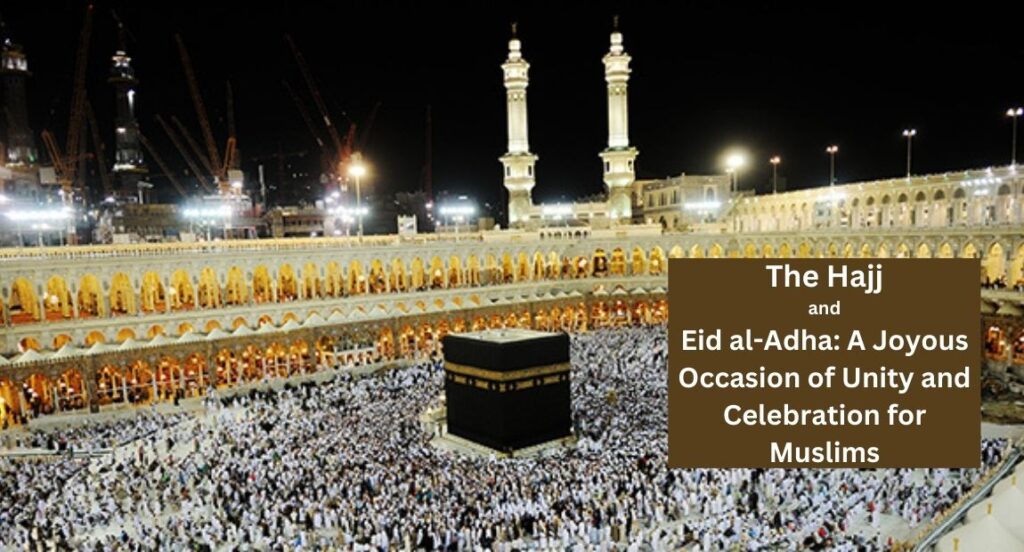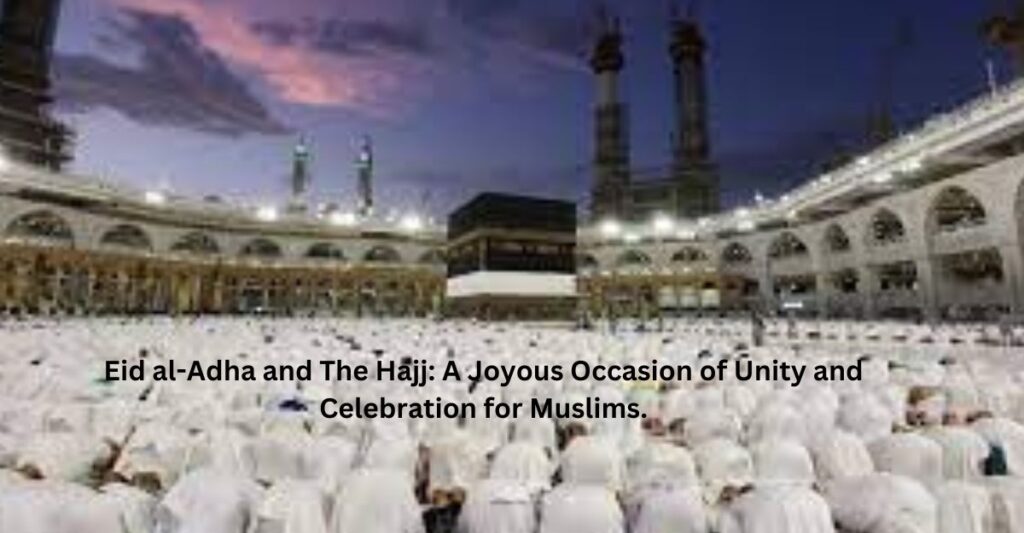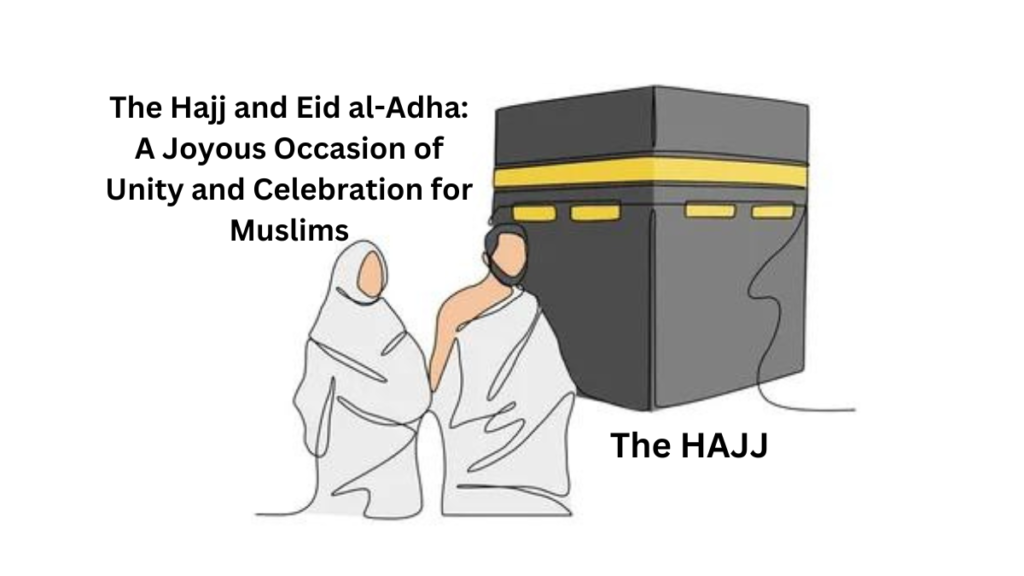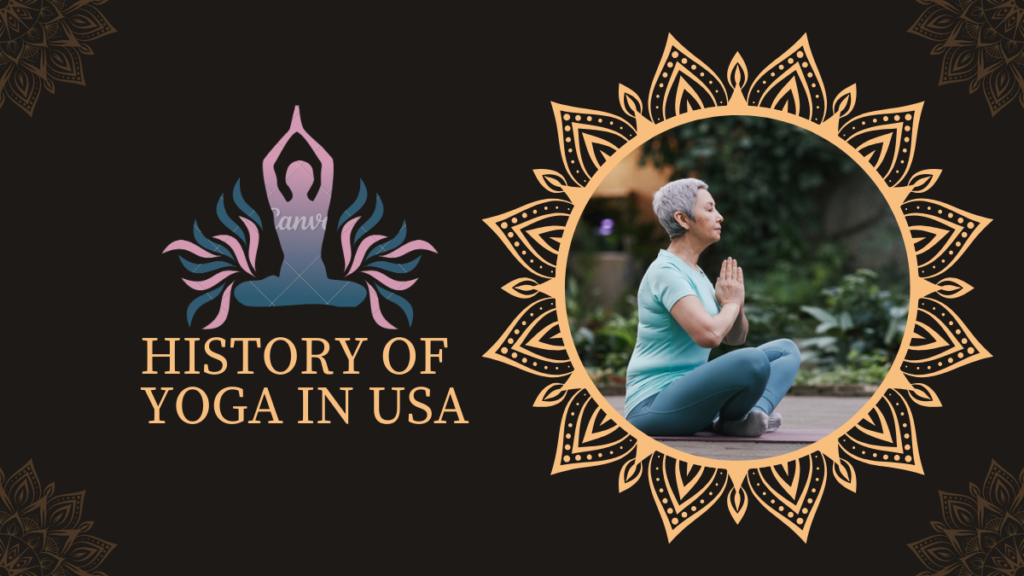The Hajj and Eid al-Adha: A Joyous Occasion of Unity and Celebration for Muslims

Festival of Sacrifice and Culmination of The Hajj: The Joyous Eid ul-Adha
Eid ul-Adha, also known as Eid al-Adha or Eid Qurban, holds immense significance in the Islamic faith and is celebrated by Muslims worldwide. This sacred holiday commemorates the story of Ibrahim (Abraham) and his unwavering devotion to God, as depicted in the Quran. Ibrahim’s willingness to sacrifice his son as an act of obedience was met with divine intervention, as Allah replaced the son with a lamb.
Table of Contents
The observance of Eid ul-Adha takes place on the tenth day of Dhu al-Hijjah, which marks the 12th and final month of the Islamic calendar. Since the Islamic calendar follows the lunar cycle, the exact date of Eid ul-Adha varies each year depending on the sighting of the moon.
Muslims engage in several religious rituals during Eid ul-Adha. The day often commences with a congregational prayer held at the mosque or in an outdoor prayer area. People dress in their finest attire and offer their prayers under the guidance of an imam or a religious figure who imparts spiritual wisdom and guidance. This joyous occasion fosters a sense of unity, devotion, and reflection within the Muslim community.
The sacrifice of an animal, typically a goat, sheep, cow, or camel, as an expression of memory and appreciation, is one of the main traditions of Eid ul-Adha. Three thirds of the flesh from the sacrificed animal is given to the family, three thirds to friends and relatives, and three thirds is given to the less fortunate.
This customary practice, the chosen animal, which can be a sheep, goat, cow, or camel, is sacrificed following a ritualistic procedure. After the sacrifice, the meat is thoughtfully divided into three parts.
During this festive occasion, the meat from the sacrificial animal is divided thoughtfully into three parts. One part is set aside to be given to those in need, providing a gesture of compassion and support to the less fortunate. Another portion is shared with relatives and friends, strengthening the bonds of kinship and community. The final part is retained for the family, symbolizing unity and celebration within the household.
Along with gift-giving and receiving, visiting family and friends, and indulging in delectable feasts made with the sacrificed flesh, Eid ul-Adha celebrations also include dining. It is a time of celebration, comradery, and introspection, highlighting the virtues of selflessness, altruism, and neighbourhood.
Eid ul-Adha, often known as Bakrid, holds a special place as the second most significant holiday in the Islamic calendar, right after Eid al-Fitr. This joyous occasion pays homage to the story of Abraham, who exemplified profound obedience to God by being willing to sacrifice his son. The celebration serves as a reminder of faith, devotion, and the willingness to submit to the divine will.
HAJJ

The Hajj is an annual pilgrimage by Muslims to the Saudi Arabian city of Mecca. Muslims who are physically and financially capable of making the trek are required to perform it as it is one of the five pillars of Islam and a necessary religious obligation.
The Hajj pilgrimage takes place in the final month of the Islamic lunar calendar, Dhu al-Hijjah. It consists of a number of rites and acts of worship that are carried out in and around Mecca at designated sites.
The Hajj
Here is a summary of the primary The Hajj ceremonies and activities:
- Ihram: The journey starts with the pilgrims entering an auspicious state of purity and sanctity known as ihram. The pilgrims wear plain white clothing that is made up of two unstitched pieces of cloth for the males and a flowy dress for the women.
- Tawaf: When pilgrims arrive in Mecca, they do Tawaf, which entails circling the Kaaba, the black cube that sits in the middle of the Grand Mosque. Anticlockwise around the Kaaba seven times, pilgrims demonstrate their dedication and unity with other believers.
- a’i: Following Tawaf, pilgrims engage in Sa’i, which is running or walking between the hills of Safa and Marwa while imitating Hajar (Hagar), the Prophet Ibrahim’s (Abraham) wife.
- Mount Arafat: The Day of Arafat is the most important part of the Hajj. In the Arafat plain, pilgrims congregate for supplication, prayer, and reflection. It is thought to be a day of great spiritual significance and a time when sins are purportedly pardoned.
- Muzdalifah: After sunset on the Day of Arafat, pilgrims proceed to Muzdalifah, where they spend the night in open grounds. They engage in prayer, collect pebbles for the next ritual, and rest before moving on to the next phase.
- Stoning of the Jamarat: By hurling stones at three pillars that symbolise Satan, pilgrims simulate the stoning of the devil. This ceremony denotes turning away from evil and temptation.
- Sacrifice: Pilgrims participate in the sacrifice of an animal, usually a sheep, goat, cow, or camel. This act symbolizes the willingness of Prophet Ibrahim to sacrifice his son and represents devotion, obedience, and gratitude to God. The meat of the sacrificed animal is distributed to the poor and shared among family and friends.
- Tawaf al-Ifadah: Following the stoning ceremony, pilgrims travel back to Mecca to take part in a second Tawaf, known as Tawaf al-Ifadah. The Hajj pilgrimage has been completed with this Tawaf.
- Farewell Tawaf: Before departing from Mecca, travellers offer a Tawaf in remembrance of the Kaaba and the sacred city.
The Hajj is a significant trip of faith, community, and deference to God. It unites Muslims from all cultures and origins while highlighting the equality and unity of believers. Muslims have the chance to improve their spirituality, ask for pardon, and strengthen their ties to Allah.
Hajj and Eid ul-Adha are two related Islamic holidays that are both important occasions in the Islamic calendar.

1 Eid ul-Adha: As was previously said, Eid ul-Adha is a holiday that honours the Prophet Ibrahim’s (Abraham’s) readiness to sacrifice his son in obedience to God. On the tenth day of Dhu al-Hijjah, the last month of the Islamic lunar calendar, it is observed. Muslims all across the world observe this day by participating in group prayers, offering a sacrificed animal (such as a goat, sheep, cow, or camel) as a sign of appreciation and sacrifice, and giving the meat to those in need in their neighbourhoods. The event emphasises the virtues of belief, submission, and charity.
2 Hajj: The Hajj is an annual pilgrimage by Muslims to the Saudi Arabian holy city of Mecca. All physically capable and financially capable Muslims must execute it at least once in their lifetimes because it is one of Islam’s five pillars. Hajj is done during the month of Dhu al-Hijjah, with particular rituals and activities taking place on predetermined days. Millions of Muslims from all over the world congregate during Hajj to engage in acts of worship and follow the example of the Prophet Ibrahim and his family.The rites entail conducting animal sacrifices, travelling between the hills of Safa and Marwa, kneeling in prayer on the plains of Arafat, staying the night in Muzdalifah, and circumambulating the Kaaba (a sacred cubic building). The hajj is a profoundly spiritual journey that stands for harmony, humility, equality, and self-submission to God.
Since the animal sacrifice given during Eid ul-Adha is a depiction of the offering made by Prophet Ibrahim, the two holidays are closely related. The festival of Eid ul-Adha marks the end of the Hajj pilgrimage and is attended by Muslims from all over the world. It is a time for sacrifice and thanksgiving.
Both Eid ul-Adha and the Hajj are extremely important Islamic holidays that emphasise the faith, unity, submission, and charitable deeds.
Author: allykazmi


